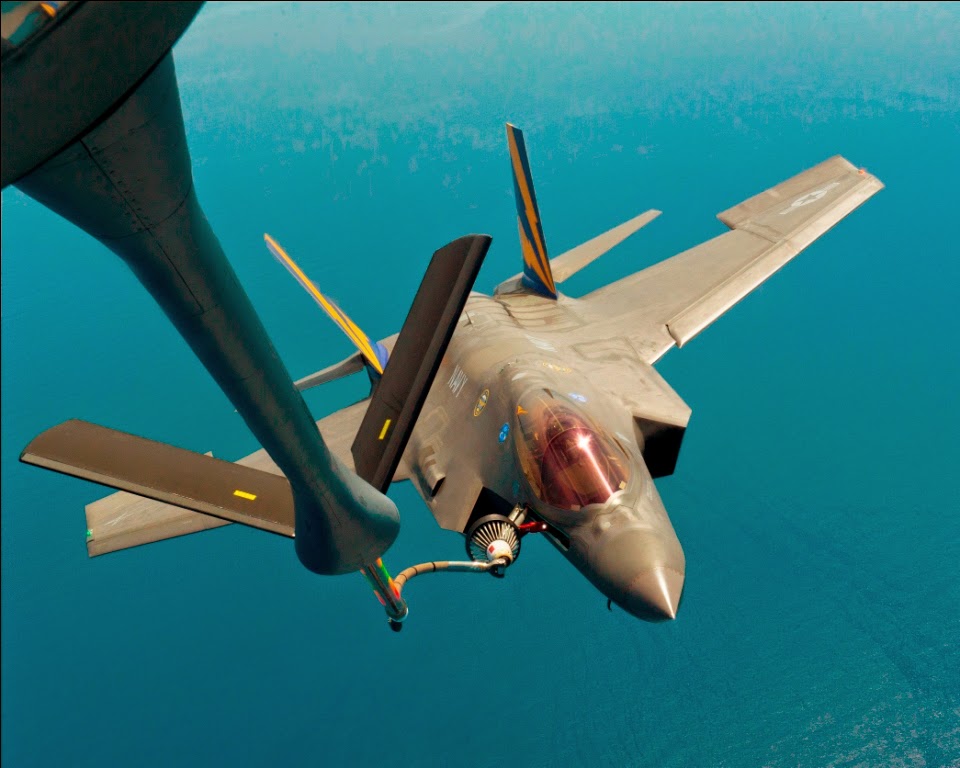Would the F-35C be a better fit for Canada?
 |
| F-35C with "probe-and-drogue" refueling. |
There is a far more elegant way to correct these shortcomings, however, simply change a letter.
 |
| Canada's planned variant, the F-35A |
 |
| But is this a better choice? |
Other aspects to the F-35C make it attractive as well. Its larger wings allow it to carry more fuel. They also fold up so that they take up less space. It is also billed as having "ruggedized structures" and "durable coatings" making it seem like a much more suitable choice for Canada's harsh climate and rugged use.
Should Canada just simply buy the F-35C?
Er... No.
While all that extra ruggedness sounds great, it translates into extra bulk. At 34,800lbs empty, the F-35C is the heaviest JSF variant, weighing in at 2,400lbs more than the F-35A. This extra bulk takes it's toll on performance, making the F-35A slower and less maneuverable than the A and B models. While the F-35C can carry more fuel, it apparently needs too because its range is nearly identical to the F-35A.
This hit to performance isn't that much of a big deal, as it puts the F-35C roughly on par with the Super Hornet.
Selecting the F-35C would have other consequences, however.
 |
| F-35B with external gun pod. |
Slower, clumsier, burns more fuel, and no internal cannon. If those were the only issues regarding the F-35C for Canada, it still might make sense. After all, the F-35's stealth and advanced sensors are meant to prevent the need for close-in dogfights where a cannon, agility, and speed might be needed.
There is one sure reason why the F-35C is not suitable for Canada, and it has nothing to do with the aircraft's performance: Its cost.
The F-35C's unit recurring flyaway cost (URF) is a full $12 million more than a F-35A. This URF is for the bare airframe only, it does not include fuel, lubricants, spares, training, support, or even an engine. This also does not include the cost of any fixes that need to be done after the aircraft has left the assembly line.
The US navy hasn't been in much of a rush to acquire the F-35C. High costs and troubles with the arrestor hook have led the USN to cut orders and push back the IOC (initial operational capability) until 2019, possibly even later. In the meantime, the USN has pushed for more Super Hornets and Growler funding. With no other customers lined up for the F-35C, the JSF's carrier variant could end up as the "bastard child" of the Lightning II family.
 |
| F-35C, not right for Canada. |
It's fatter, slower, clumsier, and has no built-in gun. It may be more rugged but it won't be operational until 2019 at the very earliest. Most damning, the F-35C is a costlier variant of an aircraft already criticized for its high costs. The likelihood of selecting the F-35C instead of the F-35A seem minuscule at best.
But weirder stuff has happened.



This is a good solution, and the one chosen back in 1977-1982 when buying the CF-18 (or CF-188). The model we bought was equipped with the more robust landing gear required by the USN, an arrestor hook, and and "wing folding mechanisms." If DND is interested still in such choices, the F-35C is indeed a better option than the A model -- assuming the F-35 is chosen at all.
ReplyDelete